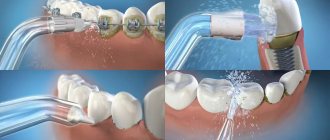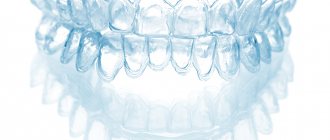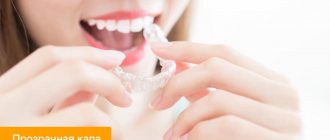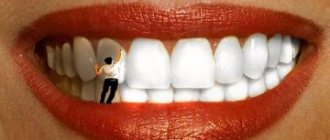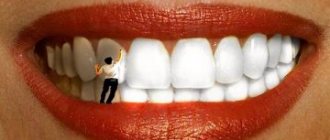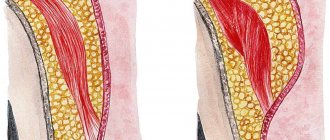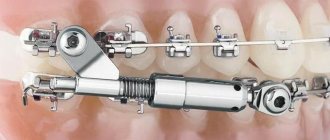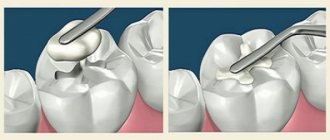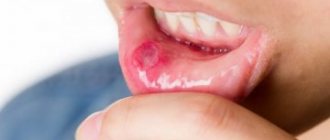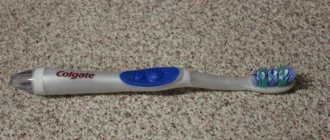Dental intervention aimed at eliminating pathological and abnormal conditions does not always require effort from the patient. A night dental guard for teeth is used as part of the treatment of bruxism, to correct the anatomical structure of the bite, in the treatment of TMJ dysfunction - and does not cause any inconvenience, since the positive effect on problem areas is created during sleep. The configuration of the elastic pads eliminates the danger of operation and guarantees the achievement of the desired result.
What is a mouthguard for bruxism?
A mouthguard for bruxism is a special plate that is worn on one or two jaws at once. Its main function is to prevent the teeth from closing together, so that during a spasm they do not rub against each other. This allows you to preserve the integrity of the enamel and prevent exacerbation of the disease.
Important! A properly made mouthguard allows you not only to protect teeth from abrasion, but also to combat various orthodontic problems - malocclusion and other dental pathologies. In addition, if there are other dental structures in the mouth, the mouth guard will protect them from deformation.
Other tasks performed by a mouthguard include the following:
- the plate helps reduce muscle pain that occurs in the jaw area during spasm;
- it reduces the load on the jaw itself, thanks to which it is possible to avoid other diseases and deterioration of the patient’s condition;
- Thanks to proper use, you can return healthy sleep to a person even if he has frequent cramps at night.
It must be remembered that the mouth guard itself is not a complete treatment for bruxism. It acts only as an auxiliary tool that allows you to keep your teeth and jaw healthy during the period of symptoms. In order to get rid of the disease completely, the patient must undergo comprehensive treatment aimed at relaxation and relieving spasms.
Benefit
Sleep guards are necessary for patients suffering from frequent seizures. Regular use:
- prevents jaw closure;
- reduces the risk of tooth decay;
- protects jaws from deformation;
- relieves tension in the temporomandibular joint.
After the first week of therapy, the person becomes calmer - he gets enough sleep and does not experience pain.
The medical accessory preserves the installed plates and braces. In children, it reduces the risk of developing malocclusion. The material does not cause allergies and creates a shock-absorbing effect.
Indications and contraindications
The main indication for use is the presence of symptoms of bruxism in a person. It does not matter how often and intensely they manifest themselves. The use of such structures is absolutely safe, so it cannot bring any negative consequences.
The age of the patient also does not matter. Mouthguards are very actively used in pediatric dentistry. This is due to their great efficiency and ease of use. However, in this case it is important to remember that children, due to their nature, may deliberately remove the plate. Therefore, to ensure quality treatment, it is necessary to conduct explanatory conversations with them and monitor the implementation of recommendations.
Other indications for use include:
- deformations of the dentition of various types;
- presence of malocclusion;
- the gaps between the teeth are too large or, conversely, too small.
All these problems can occur against the background of bruxism symptoms. In this case, the mouthguard will have a complex purpose.
As for contraindications, they practically do not exist. The structures are made from safe materials; they are securely attached to the teeth and do not cause discomfort. However, if the patient has certain mental disorders, he may be denied a mouth guard. Epilepsy is especially dangerous in this case. During an attack, the patient may accidentally swallow the plate, after which it will block his airway, thereby causing suffocation.
Manufacturing
Based on the results of the examination, the dentist will determine the desired type. Individual models are necessary for patients with jaw deformation, severely worn enamel, and severe changes in bite.
The structure is completed within a week. The process includes 3 stages:
- measurements;
- "draft model";
- low tide.
This is followed by a fitting with final adjustments.
Measurements
The dentist covers the surface of the orthopedic tray with an elastic, soft mass. The instrument is placed in the patient's mouth and an impression is made. The method is not suitable for people with a pronounced gag reflex.
Another option for taking measurements is to use special sensors to model the patient’s jaws in three-dimensional projection. A computer model helps the dentist to more carefully examine problem areas and find the right solution.
Manufacturing
The rough version is an impression of the mouth after clenching the jaw. The resulting blank is transferred to casting, which is carried out in the workshop.
A mixture based on water and gypsum powder is poured into the container. The impression is lowered into the diluted, thickened plaster. The resulting impression is placed in biologically safe silicone or plastic.
Under the influence of a pressure of 7 atmospheres and a temperature of +150 °C, the model is corrected. At the final stage, the workpiece is laminated.
The inside of a dental tray is softened to prevent chafing on the gums.
Fitting
The finished product is “fitted” by the dentist. The doctor checks the accuracy of the fit to the patient's mouth. Noticed shortcomings are corrected, and then used for their intended purpose.
Advantages and disadvantages
The main advantage of these structures for bruxism is their ease of use. Such plates do not need to be attached to the teeth or installed using additional crowns. They can be used even in the absence of a certain number of teeth in the dentition.
At the right time, the patient can independently install the structure. It is very easy to care for her. It does not require the use of additional orthodontic instruments or medications. You can also remove it at any time necessary. You don't need to visit a doctor for this.
Another plus is the availability of a wide variety of multi-colored models for the youngest patients. Many of them are afraid of carrying a foreign body in their mouth. However, designs decorated with original drawings arouse children’s interest and the treatment process for bruxism becomes more enjoyable and easier.
The main disadvantages of using mouth guards include the discomfort they cause in the patient during the first period of wearing. Usually, it takes about a week for a person to get used to the design. But, given that in most cases these plates need to be worn only at night, this disadvantage becomes insignificant.
Thermoplastic
They are produced in laboratory conditions from high-quality modern material – medical silicone. This is a unique component that has a number of undeniable advantages:
- Complete safety for health;
- Almost absolute hypoallergenicity - cases where individual intolerance to the material is identified are extremely rare;
- Does not provoke the development of caries;
- Reliably protects tooth enamel from abrasion and premature destruction.
The main advantage of silicone is the ability to change its shape even when exposed to hot water. Having slightly warmed up the product in this way, it is then immediately directed into the oral cavity, and the structure takes the specified position, taking into account the individual anatomical characteristics of the patient. Let's see how this happens:
Thermoplastic mouthguards are considered one of the most comfortable and rarely cause discomfort even during the adaptation period.
You can buy them both in the pharmacy chain and in almost any sports equipment store, however, preference should still be given to certified medical designs.
Types of mouth guards for bruxism
In modern dentistry, there are many types of mouth guards. They differ in the way they are used and the material from which they are made. In addition, their purpose may be different. It is very important that the dentist choose the most suitable option that could solve the problem more efficiently and quickly.
Day and night
Designs that are used for bruxism are divided into daytime and nighttime versions. They have differences in their appearance. Since the former need to be worn throughout the day, they usually have a neater shape and smaller sizes. Thanks to this, such plates do not interfere with talking or eating. They are made from transparent materials, which makes them almost invisible in the mouth.
As for the night ones, they are usually larger than the day ones. These structures exactly repeat the shape of the dentition, but you cannot eat or talk in them. These options are used when the patient’s symptoms of bruxism appear exclusively at night. Daytime ones are intended for more serious cases when spasms recur during the day.
Universal and customized
Universal models are made in medium sizes. They are usually used for mild forms of bruxism, as well as in cases where the person does not have associated bite problems. The advantage of such options is that they do not require additional production time. However, they also have disadvantages - they can cause slight discomfort while wearing, since they do not repeat the exact dimensions of the jaw and dentition.
Individual models are always made for each specific patient. At the initial stage, the specialist makes a cast of his jaw. Next, the design itself is manufactured according to the sketches. After fitting, the doctor can transfer the finished product to the patient for use.
Preventative, repositioning and resonating
The main purpose of preventive options is to protect the dentition. If a patient exhibits periodic symptoms of bruxism or is suspected of this disease, these are the models that are prescribed to him. Usually they are used only at night to prevent the wear of tooth enamel at a time when the person himself or his relatives cannot monitor the presence of spasms.
As for repositioning and resonating ones, these types are used for more serious cases of bruxism. In addition to the direct protective function, they also have a therapeutic purpose. Repositioning ones have an impact on the head of the jaw. When used systematically, they put pressure on this joint, changing its location. As a result, this reduces stress and prevents the onset of symptoms.
Resonating ones have a relaxing effect. Their main task is to reduce spasms by influencing the jaw muscles.
Thermoplastic
Thermoplastic is a special type of mouthguard made from a special material. It changes its properties when exposed to high temperatures. To install such structures in the mouth, they must be heated in boiling water in advance, then placed in the desired place and straightened. Thus, they take on the optimal shape, which follows all the curves and indentations in the dentition. When choosing such plates, the doctor is obliged to familiarize the patient in detail with the features of their use.
Reasons for the development of pathology
The appearance of snoring is explained by a narrowing of the lumen of the upper respiratory tract, which during wakefulness is in good shape and retains the elasticity of the walls. At night, the muscles relax a little, the walls of the airways move and begin to vibrate when breathing. We hear this vibration as snoring.
There are quite a few reasons why snoring occurs. The most common are:
- anatomical disorders leading to narrowing of the airways, including a deviated nasal septum;
- congenital narrowness of the airways;
- nasal polyps;
- malocclusion, small jaw, displaced back;
- enlarged tonsils;
- fat deposits in the throat area due to excess weight;
- elongated uvula.
There are also factors that contribute to the reduction of nasopharyngeal muscles, regardless of the presence of diseases. These are alcohol intake, lack of sleep, use of sleeping pills, menopause or thyroid dysfunction.
Snoring is a symptom of one of the most unpleasant diseases - obstructive sleep apnea syndrome. Because of it, a person periodically stops breathing altogether during sleep. This leads to decreased oxygen levels in the blood, frequent awakenings, drowsiness, and other problems.
How are mouth guards made for teeth grinding?
The manufacture of these structures is carried out in special laboratories. For this purpose, modern high-quality polymers are used. They are resistant to mechanical and chemical influences and also have a long service life. Such materials can have different colors - from transparent to any bright shades.
To custom make a structure for bruxism, a specialist must first make an impression of the patient’s jaw. This is necessary in order to see the exact location of the jaw, as well as to note all the irregularities of the dentition. Thanks to this, you can make a model that exactly matches the surface of the teeth and will not cause discomfort while wearing.
Production time
The time required to manufacture the structure depends on the material used, as well as on the structural features of the patient’s dentition. There are cases when, after fitting, the doctor identifies certain inconsistencies that also need to be eliminated.
Usually it is possible to make a high-quality structure for the treatment of bruxism in 1-1.5 weeks. If there are serious violations, the dentist may recommend urgent production.
Important! The period required to manufacture the structure should be taken into account when ordering a second copy. Since there can be no pauses in therapy, it is better to order it even before the first one becomes unusable.
How does a mouth guard work? Instructions for use
An individual anti-snoring mouth guard ensures that the lower jaw moves forward several millimeters. This is quite enough to increase the distance between the walls of the oropharynx and relieve a person from snoring. By fixing the jaw in this position throughout the night, it can no longer move back and block breathing.
Schematic representation of the state of the respiratory tract when sleeping with and without a mouthguard
Using an anti-snoring mouth guard is quite simple. Necessary:
- Purchase a suitable device. You can take a universal model and adjust it to size or order an individual one.
- Carefully study the instructions for the product. As a rule, the mouth guard needs to be “welded” before wearing for the first time. To do this, the workpiece is placed in water at a temperature of 75°C. When it softens a little, you need to take it out, place it in a glass of cold water for a few seconds, and then insert it into your mouth. Using this simple method, universal models are adjusted to the characteristics of a particular person.
- Wear the product every day after brushing your teeth before going to bed. Don't take it off until the morning.
Before starting to use a snoring guard , you must consult a doctor: a somnologist, an orthodontist, an osteopath. It also wouldn’t hurt to visit an ENT specialist and other doctors who can identify the causes of snoring. Treatment must be carried out in combination, since the mouthguard is not a medicine. It simply removes the symptoms and slightly affects the bite. As soon as a person stops wearing the device at night, the problem of snoring and apnea returns.
Some people are afraid that they will not be able to get used to using the mouthguard. But on average, patients stop noticing the device after a week of constant use. Sometimes it takes about two weeks or even a month, it all depends on the individual characteristics of the person.
Recommendations for care and storage
It is very easy to maintain the structure. To do this, you should adhere to the following recommendations:
- After use, it must be rinsed with running water to remove bacteria, food debris, etc. If it becomes very dirty, you can use your usual toothpaste and brush.
- After washing, the structure should be carefully wiped.
- Do not expose the plate to high temperatures. It should not be boiled or dried with a hairdryer. Also, do not leave the plate in the open sun.
Throughout the entire period of using the bruxism mouth guard, the patient should carefully monitor its condition. If any deformations occur in the design, this may indicate that it is not suitable, or that the person has begun to experience complications. In each of these cases, you must immediately consult your doctor.
It is better to use special containers for storage. They can be ordered during the purchase of the structure itself. They will keep the plate clean and prevent any damage.
When is an anti-snoring mouth guard needed?
Indications for purchasing an anti-snoring device are the following problems:
- actual snoring of any nature, if noticed;
- mild to moderate apnea;
- increased airway resistance syndrome;
- use of PAP therapy to reduce the burden of the PAP machine.
A snoring mouthguard is one of the most convenient methods of treatment, because it is light, small, easily fits in a pocket, and is invisible. You can take it on vacation or any other trip. No one will know that you use special anti-snoring products while you sleep.
Functions
Main functions of structures:
- Protecting the enamel surface from early abrasion;
- Protection of organs from destruction;
- Maintaining the integrity of prosthetic devices;
- Minimizing pressure on the articular head during spasm;
- Elimination of muscle pain;
- Protection against deformation and development of inflammatory processes;
- Prevention against mobility, loosening and displacement of malocclusions;
- Muscle relaxation during sleep.
Universal
They are characterized by a less pronounced effect on the correction of teeth, and, therefore, do not give such a high result in the treatment process than the product described above. Its undeniable advantage is the low price.
Flaws:
- The model has a standard shape and is not able to take into account the anatomical features of the structure of the jaw apparatus;
- In the production process of mouth guards, mainly low-grade materials are used, which often provoke allergies. They can cause discomfort during use, and in some cases can provoke the development of malocclusions, which will subsequently have to be further treated.
The use of universal mouthguards is necessarily accompanied by complex therapy, taking medications containing large quantities of calcium, which strengthens bone tissue, magnesium and vitamin B complex.
It is important to understand that if this disease is the result of bite deviations, in parallel you should be observed by an orthodontist and, if necessary, receive appropriate treatment.
Another significant drawback of universal models is the appearance of bad breath. This arises from the fact that the material, which is of low quality, absorbs foreign odors, which are then almost impossible to eliminate.
